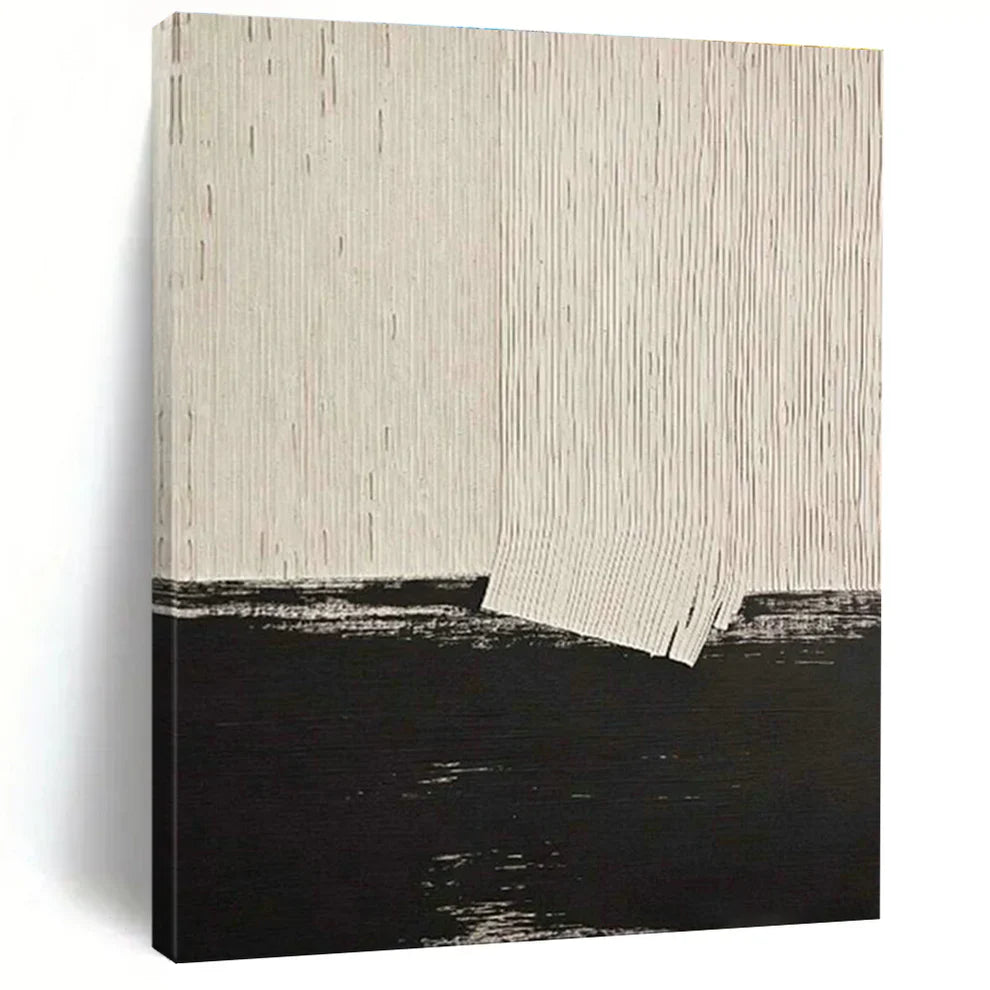
The Power of Contrast - A Deep Dive into a Textured Black and White Abstract
Share
In the world of art, sometimes the most profound statements are made with the simplest palettes. This powerful piece of abstract art is a stunning example of that principle. The Black and White Striped Abstract Art for Minimalist Office & Monochrome Bedroom DLZ2203 is a masterclass in minimalist design, using only two colors—black and white—to create a work that is rich in texture, emotion, and visual interest. As a prominent piece within a curated collection of Black And White Wall art, this artwork stands out for its bold division and compelling use of line.
The painting is a study in dichotomy. It is split horizontally into two distinct halves, but the separation is not a harsh line; rather, it is a dynamic interaction between the two fields. The upper half is a field of textured white, a canvas of meticulously rendered vertical lines that create a sense of rhythm and calm. These lines, applied with a thick, tactile impasto, give the surface a fabric-like quality, almost like a woven tapestry or a gently flowing curtain. The texture is the primary focus here, inviting the viewer to look closer and appreciate the subtle variations in light and shadow that play across the surface. This technique, where texture becomes the main subject, is a hallmark of certain modern art movements and is a key element in works by artists like Alberto Burri and Antoni Tàpies, whose work often explores the materiality of paint itself. You can find more information about artists who use texture as a primary medium on the Tate Modern website.
The lower half of the painting provides a striking contrast. It is a dense, almost monolithic field of black. Unlike the delicate vertical lines above, the black paint is applied with broad, sweeping horizontal strokes. This creates a sense of immense weight and gravity, grounding the piece and anchoring the more ethereal white section. The contrast is not just in color but also in movement: the upward, vertical energy of the white is met by the horizontal, grounding force of the black. The two sections meet in a dramatic collision, with the white "curtain" appearing to peel away or fall into the black abyss below. This moment of transition is the emotional core of the painting, creating a narrative tension between light and darkness, order and chaos.
The use of a limited palette of black and white is a deliberate choice, forcing the viewer to focus on form, line, and texture rather than color. This approach is reminiscent of the work of many influential artists in the 20th century. For example, artists from the Abstract Expressionist movement, such as Franz Kline, often worked in black and white to explore the raw power of gesture and form without the distraction of color. You can find a fascinating exploration of this and other art movements at the Art Institute of Chicago. This minimalist approach has a timeless appeal and fits seamlessly into a wide range of interior design styles, from modern and Scandinavian to industrial and minimalist. The artwork becomes not just a decoration but a philosophical statement about balance, contrast, and the beauty found in simplicity.

The Artist's Vision and Journey
The artist's creative journey is rooted in a fascination with texture and the power of a limited color palette. Their work is a rebellion against the overstimulation of the modern world, a quiet call for contemplation and a return to fundamental aesthetic principles. The artist's philosophy is that true beauty can be found in the interplay of light and shadow, and that color can sometimes be a distraction from the essential form of a work. This idea has a long history, as seen in the works of photographers and artists who explored the nuances of monochrome, and for a deeper understanding of this rich history, you can read more on the MoMA website's photography archives.
The artist's process is a meditative one. Each stroke, each line, is a deliberate act, a form of controlled expression. The creation of the textured surface in the white section is a painstaking process, requiring patience and precision to achieve the desired effect of rhythm and movement. In contrast, the black section is often applied with a more gestural, spontaneous energy, a reflection of the more primal, emotional side of the human experience. This duality in the creative process itself mirrors the duality presented in the final artwork. For the artist, the piece is a metaphor for the human condition—the orderly, structured side of our lives coexisting with the dark, untamed parts of our being.
The artist’s path was one of continuous refinement, moving from more complex and colorful works to the stark, powerful simplicity of their current style. This journey of stripping away the unnecessary is what gives their work its power. They believe that by removing the distraction of color, they can create a more direct and honest connection with the viewer, allowing the textures and forms to speak for themselves.

Customer Reviews
"This painting is perfect for my minimalist office. It’s not just a decoration, it’s a piece of art that makes a statement. The texture is amazing in person." - Michael P.
"I bought this for my new apartment, and it has completely transformed the space. The black and white is so sophisticated, and I love the way the texture catches the light." - Jessica H.
"The quality is excellent. It’s even better than the photos online. The contrast is so powerful yet elegant. Highly recommend it." - Ethan W.
Frequently Asked Questions (FAQ)
Q: Is this an original painting or a print? A: This artwork is a high-quality reproduction of an original painting. The unique texture is meticulously recreated to mimic the feel of the artist's original work, ensuring a stunning, tactile finish.
Q: How do I hang this painting? A: The canvas comes with pre-installed hanging hardware, so it is ready to be mounted on your wall straight out of the box.
Q: What is the best way to clean this textured canvas? A: Due to its delicate texture, we recommend cleaning this artwork by gently dusting it with a soft, dry cloth or a feather duster. Please avoid using water or chemical cleaners, as they could damage the surface.
Q: Can this painting be hung in a high-humidity area like a bathroom? A: We do not recommend hanging this artwork in areas with high humidity, as it can potentially affect the canvas and the textured medium over time.
Q: What type of interior design styles does this piece fit? A: This black and white abstract painting is incredibly versatile. It is a perfect fit for modern, minimalist, Scandinavian, industrial, and monochromatic interior design themes.
